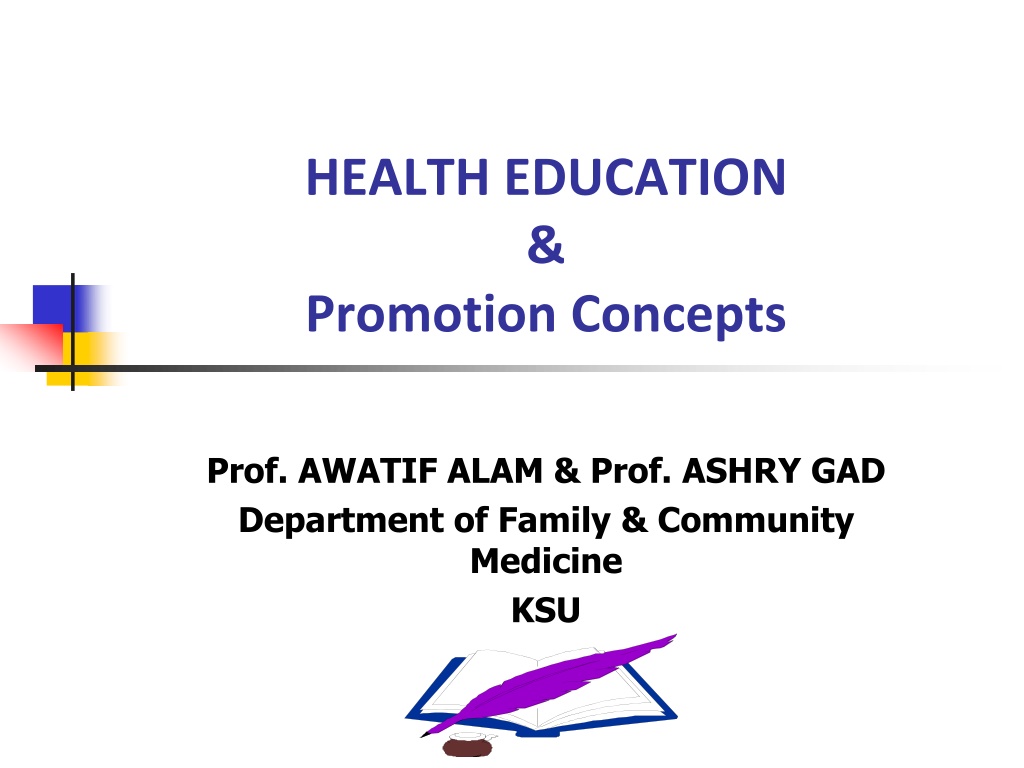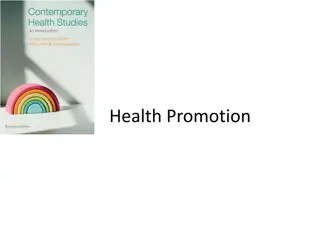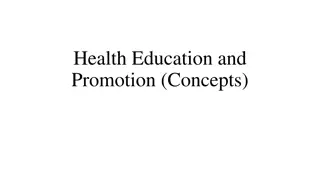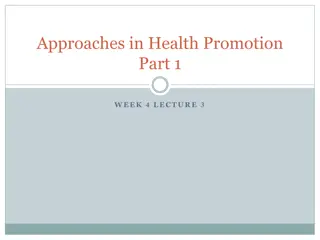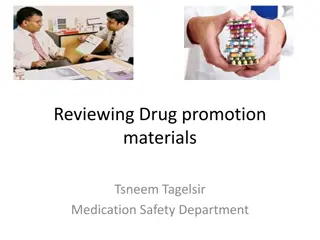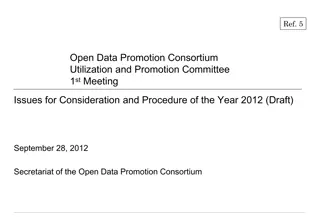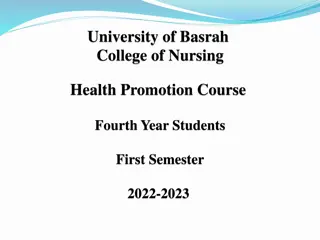Understanding Health Education and Promotion Concepts
Health education is the process through which individuals and groups learn to promote, maintain, and restore health while addressing risks and preventing diseases and injuries. Health promotion involves planned actions to improve living conditions conducive to health, empower individuals, and create supportive environments. Basic characteristics include promoting public health policy, community actions, personal skills development, and re-orienting health services. The triad of health promotion encompasses health education, health protection, and disease prevention.
Download Presentation

Please find below an Image/Link to download the presentation.
The content on the website is provided AS IS for your information and personal use only. It may not be sold, licensed, or shared on other websites without obtaining consent from the author. Download presentation by click this link. If you encounter any issues during the download, it is possible that the publisher has removed the file from their server.
E N D
Presentation Transcript
HEALTH EDUCATION & Promotion Concepts Prof. AWATIF ALAM & Prof. ASHRY GAD Department of Family & Community Medicine KSU
Definition: Health education is the process by which individuals and group of people learn to : Promote, Maintain, Restore health Address risks, prevent disease/injury Education for health begins with people as they are, with whatever interests they may have in improving their living conditions .
DEFINITIONS OF HEALTH PROMOTION A planned combination of educational, political, regulatory, and organizational supports for actions and conditions of living conducive to the health of individuals, groups, or communities. Green & Kreuter, 1999
DEFINITIONS OF HEALTH PROMOTION The process of enabling people to increase control over and improve their health A commitment to dealing with challenges of reducing inequities, extending the scope of prevention, and helping people to cope with their circumstances Creating environments conducive to health, in which people are better able to take care of themselves
BASIC CHARACTERISTICS OF HEALTH PROMOTION 1. Enabling people to take control over, and responsibility for, their health as an important component of everyday life. 2. Requiring the close cooperation of sectors beyond the health services. 3. Combining diverse, but complimentary, methods or approaches. 4. Encouraging effective and concrete public participation.
Health Promotion Action Means: Build Public Health Policy Create Supportive Environments Strengthen Community Actions Develop Personal Skills Re-orient Health Services Moving into the future
THE TRIAD OF HEALTH PROMOTION HEALTH EDUCATION HEALTH PROTECTION DISEASE PREVENTION
The Health Promotion Triad Health Education Health Protection Prevention
DISEASE PREVENTION THREE LEVELS Primary Secondary Tertiary
Primary Prevention Secondary Prevention Tertiary Prevention Cure Chronic disease Biological onset of disease Clinical Course of disease Healthy individual Disability Death Functional Status Risk Factors Asymptomatic signs Symptoms and signs Rehabilitation Support Immunization Health Education Prophylaxis Screening Surveillance Diagnosis Treatment Compliance Adherence The Phases of Prevention in relation to natural history of disease
Health Promotion Context: Place of Health Education in Public Health
HEALTH PROMOTION MODELS THREE SPHERES Health Education Prevention Health Protection SEVEN DOMAINS 1. Prevention 2. Lifestyle 3. Preventive Policies 4. Policy Maker Education 5. Health Education 6. Health Protection 7. Policy Support
Health Promotion (Ottawa Charter) Process of enabling people to increase control over, and to improve, their health . health promotion is not just the responsibility of health sector, but goes beyond healthy life styles to well being Health Promotion concept recognizes the role of socio-political environment, public policies, health system and access to care, physical environment, culture, and health related attitudes and behaviors towards health and diseases. Health Education targets health related beliefs, attitudes and behaviors of individuals and populations. Therefore, while Health Education plays an important role there is a need to understand that a larger role is played by national policies, social context, cultural values, health system access 13
Health Promotion Framework Advocacy to make political, economic, social, environmental, cultural, behavioral & biological factors favorable to health. Enable people by ensuring equal opportunities associated text refers to opportunities for access to information, life skills, and making health choices (HEALTH EDUCATION contributes to achieving this goal) -- [and this enables person to take action] Mediate a coordinated action by government, health, social and economic sectors, NGOs, Industry, professional & social groups 14
Health Promotion Actions Healthy Public Policies -- for healthier goods & services, healthier environment, equal opportunities Creation of Supportive Environment Environment - Social, Physical Work, Community, Society levels Strengthening Community Actions Community participation, empowerment, action. Health Education also helps in empowering people for effective participation and taking part in actions which make positive changes to environment, health care services, policies 15
Health Promotion Actions (contd.) Develop Personal Skills By education, information, training Reorient Health Services Health sector must move in a HP direction beyond clinical Respect cultural needs 16
Targets of health education: definitions Health Behaviour: Activity undertaken for the purpose of prevention of diseases, or detecting these at an early stage, or managing them effectively Belief: A statement or body of statements held to be true by an individual or group. Attitude: Position, disposition, or manner with regard to a person or thing 17
AIMS OF HEALTH EDUCATION: 1. To develop a sense of responsibility for health conditions, as individuals, as members of families & communities. (Promotion ,prevention of disease & early diagnosis and management ). While, as mentioned previously, environment, policy, social context plays a major role towards shaping the health attitudes and behaviors, information, knowledge and skills at personal level are also important to adopt healthy behaviors 2. To promote and wisely use the available health services. 3. To be part of all education, and to continue throughout whole span of life.
Process of health education: Dissemination of scientific knowledge about how to promote and maintain health), lead to changes in the Knowledge, Attitudes, and Practices (behavior) related to such changes.
Steps for adopting new ideas & practices : AWARENESS (Know about new ideas) INTEREST (Seeks more details ) EVALUATION (Advantages versus disadvant.+ testing usefulness ) TRIAL(Decision put into practice) ADOPTION (person feels newidea is good and adopts it)
Contents of Health Education RISK FACTORS: e.g. smoking, drugs, road traffic accident risks HEALTH ENHACING PRACTICES: e.g. exercise, nutrition OCCUPATIONAL FACTORS: Safety, Hygiene INFECTION CONTROL: e.g. hand washing CHRONIC ILLNESS, MENTAL HELATH: Knowledge about risks, improvement actions such as promoting togetherness SEXUAL HEALTH i.e. information about STI HEALTH SERVICES: Information about access, Awareness about the need to use the health services SPECIAL GROUPS (food handlers, occupations, mothers, school health)
Principles of Health Education Interest Participation Motivation Comprehension Proceeding from the known to the unknown Reinforcement through repetition Good human relations People, facts and media: knowledgeable, attractive , palatable & acceptable .
Principles of Health Education Learning by doing: If I hear, I forget If I see, I remember If I do, I know . Motivation i.e. awakening the desire to know and learn: - Primary motives, e.g. inborn desires, hunger - Secondary motives, i.e. desires created by incentives such as praise, love, recognition, competition.
Health Education: Individuals About For example, for Healthy behaviors (e.g. breast feeding), secondary prevention Settings where education is imparted Health care settings, Home, Video/Internet Approaches to health education for individuals Risk assessments in various settings Information, contract, evaluation for behavior change Methods for health education for individuals Information provision in-person, print/electronic media Issues High Cost, Focus on Disease rather than on health 24
Health Education: Groups About Behavior change, supportive environment, community action, access to care Settings Health care settings, community, workplace Approaches Knowledge & skill development Peer learning Training for behavior change Methods Didactic & experiential methods Issues Difficult to comprehend and manage group dynamics, difficult to achieve skills to facilitate groups 25
Communication in health education: Education is primarily a matter of communication, the components of which are: CHANNELS AUDIENCE MESSAGE - Individual - Conform with - Educator - Media - Group objectives. ----------------------------------------------------------------------------------------- - 2 way- Public - understandable - needs+ interest of audience ----------------------------------------------------------------------------------------- - 1 way- Public- Acceptable - ? Content of message ----------------------------------------------------------------------------------------- COMMUNICATOR
Evaluation of health education programs: There should be continuous evaluation. Evaluation should not be left to the end but should be done from time to time for purpose of making modifications to achieve better results.
EVALUATION CYCLE: Describe problemDescribe programState goalsDetermine needed information Modify programEstablish basis for proof of effectiveness Analyze &compareOrganize dataDevelop& testDetermine data results baseinstruments collecting method
